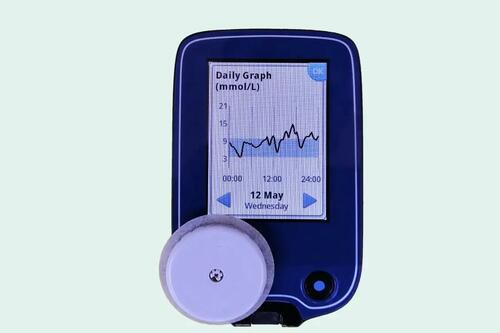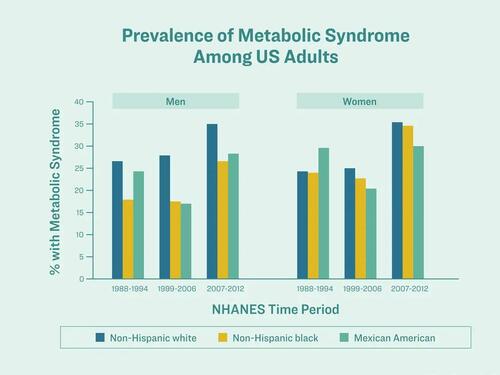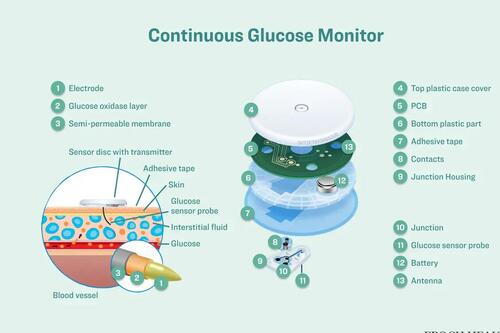Wearing A Continuous Glucose Monitor: Troubling Trend Or Health Hack?
Authored by Sheramy Tsai via The Epoch Times (emphasis ours),

In January 2023, 42-year-old Jenni Southerington reached a pivotal moment in her health. Skeptical about her prediabetes diagnosis, she started using a continuous glucose monitor. The device’s two-week data revealed unexpected morning glucose spikes despite strict fasting. Ms. Southerington found that certain foods would worsen her condition. “Eating a spoonful of rice had the same effect as half a cup,” she said.
Her experience underscores a growing trend of people without diabetes monitoring their blood sugar, either out of concern over disease or to optimize their health. But while these devices can offer valuable insight, many people may not need them and could suffer unneeded expense and stress from using them, experts warn.
CGMs Demystified
Continuous glucose monitors (CGMs) are small, wearable devices that provide real-time data on blood sugar with a sensor typically placed on the arm or abdomen.
Unlike traditional fingerstick tests, CGMs don’t require repeated skin punctures. CGMs gauge glucose in the interstitial fluid—the fluid between body tissues. The collected data is wirelessly relayed to a user’s choice of device, be it to a smartphone app, a watch, or directly to an insulin pump, typically every five minutes or about 288 times a day.
“At their core, CGMs provide knowledge, and knowledge is power. Any person wearing a CGM can better understand how different foods and activities affect their glucose levels,” Dr. Andrew Demidowich, assistant professor in the Division of Endocrinology at Johns Hopkins Medicine, told The Epoch Times.
Not everyone shares Dr. Demidowich’s enthusiasm.
The Central Role of Glucose in Metabolic Health
Glucose, a simple sugar, is a key fuel source for the body, but it creates problems if it builds up in the blood. High blood glucose is more than just a marker for diabetes—it’s a central player in poor metabolic health. Metabolic diseases, which include diabetes, obesity, and heart disease, are increasing globally. The Centers for Disease Control and Prevention highlights that more than one-third of U.S. adults suffer from a cluster of conditions known as metabolic syndrome, which includes high blood pressure, high blood sugar, excess body fat around the waist, and abnormal cholesterol levels.
Processed foods, including refined grains and sugars, as well as an increasingly sedentary lifestyle are wreaking havoc on people’s metabolic health. The rise of diabetes and obesity have been linked to processed foods that cause significant spikes in blood sugar. And while exercise can help manage these effects, especially after eating, many people prefer more passive forms of entertainment.
Rapid fluctuations in glucose can stress the body and trigger inflammation, which can lead to chronic diseases such as heart disease, arthritis, and certain cancers. Watching glucose levels can help people understand what improves their blood sugar level—and what makes it worse.
“I often tell my patients that we are all unique, and how one person’s sugar levels react to a certain food, like a banana or orange, may be completely different in how it may affect another person,” Dr. Demidowich said.
CGMs for All
CGMs were once limited to diabetes care. Initially vital for the 1.9 million Americans with Type 1 diabetes requiring daily monitoring, CGMs are now being used by a much broader demographic. This shift is significant in a nation in which an estimated 38 million people live with diabetes.
CGMs can provide real-time insights into the effects of lifestyle choices on glucose levels. Diet is just one of the many factors affecting glucose levels—exercise, stress, sleep, illness, dehydration, and pain also play significant roles.
More people are using CGMs as a way to self-optimize their health and make better decisions about food, physical activity, and more. The growing use of CGMs signifies a shift toward personalized, data-driven health and wellness strategies.
A 2018 Stanford University study, led by professor Michael Snyder, uncovered frequent and previously undetected blood sugar spikes in healthy individuals.
“There are lots of folks running around with their glucose levels spiking, and they don’t even know it,” Mr. Snyder said in a statement, underscoring the risk these spikes pose for cardiovascular disease and insulin resistance, a diabetes precursor.
The study, using CGMs on participants, suggests that even those without diabetes can experience significant glucose fluctuations.
“We think that these continuous glucose monitors will be important in providing the right information earlier on so that people can make changes to their diet should they need to,” Mr. Snyder said.
Echoing these potential benefits, a related study by George Washington University researchers found that 90 percent of CGM users reported shifts toward healthier living, with nearly 50 percent of them more inclined to exercise after noticing blood glucose spikes and 87 percent modifying their diets based on the feedback from their devices.
Dr. Demidowich has seen these effects himself, which is why he encourages patients with prediabetes to use the devices.
“I’m a big proponent of people with prediabetes wearing a CGM, even if just for a short time like 2 to 4 weeks, to better understand how to optimize their lifestyle and diet to avoid progression to diabetes,” he told The Epoch Times.
Real-time data can change patient behavior, he said.
“As providers, we can recommend cutting out sugary beverages or processed foods, but when patients see their sugar levels spiking in real-time, that becomes a powerful impetus for change.”
Too Much Information?
However, not everyone shares this enthusiasm for widespread CGM use. Dr. Robert H. Shmerling, senior faculty editor at Harvard Health Publishing, raises an issue with the devices’ utility for non-diabetics. He says there isn’t conclusive research demonstrating benefits for this group, pointing out that most people without diabetes naturally maintain normal blood sugar levels.
“Just because you can measure something doesn’t mean you should,” Dr. Shmerling wrote in an article. CGM use in the nondiabetic population may be premature and driven more by marketing than medical necessity, he cautioned. He noted that unnecessary monitoring could lead to false alarms, increased anxiety, and possibly harmful interventions.
Some people simply don’t know what healthy blood sugar looks like, and that can lead to confusion and fear, which can undermine, rather than improve, health.
Dr. Shmerling’s skepticism is echoed by 70-year-old Bob Volat, a Type 1 diabetes patient since age 59 who praises CGMs as a transformative tool in his health journey, calling them “an absolute gift.”
However, in a conversation with The Epoch Times, Mr. Volat questioned the utility of such advanced technology for nondiabetics, viewing it as overly complex and potentially motivated by profit. The devices aren’t cheap and he believes people may be swayed by aggressive marketing.
Rather than purchasing devices, he advises that people take a more holistic approach to health that goes beyond a singular focus on glucose levels.
Decoding Blood Sugar: Understanding Spikes and Glucose Tolerance
Prediabetes and diabetes are diagnosed based on specific blood glucose levels and A1C test results. The A1C test, measuring average blood sugar over two to three months, offers a comprehensive view of long-term glucose control.
Beyond these diagnostic benchmarks, there’s an increasing focus on the intricacies of blood sugar regulation, especially the health impacts of frequent sugar spikes, which CGM devices can adeptly identify.
Read more here…
Tyler Durden
Sun, 01/21/2024 – 22:10
via ZeroHedge News https://ift.tt/q9G0463 Tyler Durden


